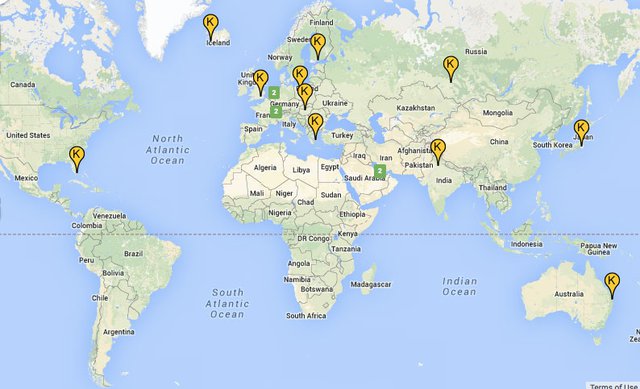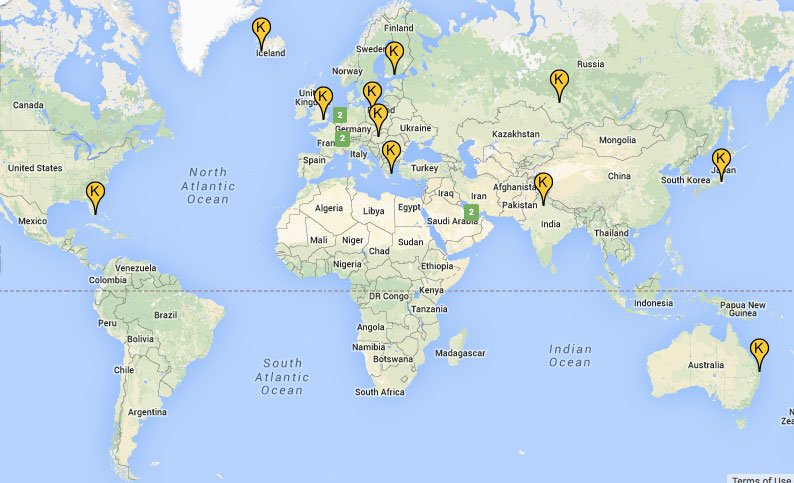We used RIPE Atlas to measure latency times to K-root, and we believe we can improve those times by adding new nodes to K-root in strategic locations. Here, we propose the idea of developing an experiment that would let us measure this potential improvement.
Background
One of the services the RIPE NCC provides beyond its core role as a Regional Internet Registry is the operation of K-root, one of the world’s 13 name servers for the root zone of the Domain Name System (DNS) that make up a crucial part of the Internet’s infrastructure. ( Read more about the RIPE NCC’s operation of the K-root name server.)
Right now, the RIPE NCC operates K-root from five global nodes (Amsterdam, NL; London, GB, Tokyo, JP; Miami, US; Frankfurt, DE) and 12 local nodes (Budapest, HU; Milan, IT; Helsinki, FI; Reykjavik, IS; Poznan, PL; Geneva, CH; Delhi, IN; Athens, GR; Doha, QA; Novosibirsk, RU; Abu Dhabi, AE; Brisbane, AU). Combined, these nodes answer an average of approximately 25,000 requests per second – that’s 90,000,000 requests every hour – from all over the world.

We believe that every Internet user, regardless of their proximity to one of these K-root nodes or another root name server, should have the best possible access to K-root in order to ensure the most robust, reliable Internet possible. To that end, we're proposing an expansion of K-root that would allow us to better serve network operators, and Internet users in general, across the globe in the most efficient manner possible.
Current Global Access to K-root
The RIPE NCC recently used the RIPE Atlas global network of probes to measure latency times to K-root from a number of locations across the globe. Below are the average global round-trip times (RTTs) and number of hops we found for RIPE Atlas probes accessing K-root from ten different regions around the world. We've also included the measurements for the regions with the shortest and longest RTTs to K-root.
| IPv4 | IPv6 | |
| Global average RTT (ms) | 100.45 | 124.64 |
| Global average hops | 15.32 | 10.47 |
| RIPE NCC Service Region average RTT (ms) | 28.88 | 22.96 |
| RIPE NCC Service Region average number hops | 11.56 | 9.78 |
| Longest average RTT (ms) |
222.85 (South America) |
222.30 (Asia Pacific) |
| Largest average number hops |
24.71 (Caribbean) |
17.83 (Asia Pacific) |
You can also see the full details and a breakdown of measurements per region for IPv4 and IPv6 .
Expansion Experiment to Improve K-root Access
We believe it’s possible to significantly improve round-trip times to K-root, and are planning an experiment using additional nodes to test what kind of improvement we can achieve in various regions. We will choose these locations strategically, based on where we believe we can achieve the biggest impact. We will try to asses how we can reduce the average hop count and latency by approximately 5%. Please note these are soft goals at this stage and will be used by us to give us a measure on the effort that is required to make a solid amount of improvement in any given region.
Throughout the experiment, we will also periodically repeat the RIPE Atlas measurements we made in determining response times to K-root in order to assess the results and determine what impact the additional nodes have on improving those times.
As we define the experiment, we will publish more specific details about how many nodes we will add, in which locations, and what kind of improvement we might expect.
If you have any feedback about these plans, please leave a comment or share your feedback on the DNS Working Group Mailing List .





Comments 0
The comments section is closed for articles published more than a year ago. If you'd like to inform us of any issues, please contact us.